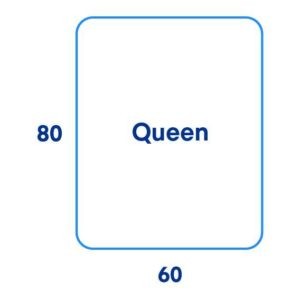Choosing the right mattress size is a crucial decision for ensuring a good night’s sleep. Among the various options available, the queen size bed stands out as a consistently popular choice. But How Big Is A Queen Bed exactly? Understanding the dimensions of a queen mattress, along with considering factors like room size and sleeping arrangements, is key to making an informed decision. This guide will delve into the specifics of queen bed dimensions, explore who queen beds are best suited for, and compare them to other mattress sizes to help you determine if a queen bed is the perfect fit for your needs.
Queen Bed Dimensions in Detail
A standard queen size mattress measures 60 inches wide by 80 inches long. In metric terms, this translates to approximately 152 centimeters in width and 203.5 centimeters in length. These dimensions make the queen bed a versatile option, striking a balance between spaciousness and space-saving practicality.
To visualize this size, imagine a rectangle that is five feet wide and six feet eight inches long. This footprint offers a significant upgrade in space compared to smaller sizes like full or twin beds, while remaining more compact than larger options like king or California king mattresses.
Is a Queen Bed Right for You? Consider These Factors
The popularity of queen beds stems from their adaptability to various needs and living situations. Here’s a breakdown of who typically finds a queen bed to be an ideal choice:
For Couples Who Value Space
Queen beds are a favored option for couples who desire more personal sleeping space than a full bed can offer, but may not require or have room for the expansive dimensions of a king bed. While a full bed provides each person with only 27 inches of personal space, a queen bed increases this to 30 inches per person. This extra few inches can make a noticeable difference in comfort, reducing sleep disturbances caused by a partner’s movements.
For Single Adults Seeking Luxury
Single adults who appreciate extra room to stretch out and move around during sleep often find queen beds to be a luxurious upgrade from smaller single-sleeper mattresses. A queen bed allows for ample space to sprawl, change sleeping positions freely, and generally enjoy a more unrestricted sleep experience.
For Guest Rooms Designed for Comfort
Queen beds are frequently chosen for guest rooms as they comfortably accommodate both solo visitors and couples. Providing a queen bed in a guest room ensures that your visitors have a spacious and comfortable sleeping arrangement, enhancing their overall stay.
For Smaller Bedrooms Where Space is a Consideration
While offering generous sleeping space, queen beds are designed to fit comfortably into most standard-sized bedrooms. They are less demanding in terms of room size compared to king or California king beds, making them a practical choice for bedrooms where maximizing floor space is important. A minimum recommended room size for a queen bed is generally around 10 feet by 10 feet. This allows for comfortable placement of the bed and other essential bedroom furniture without overcrowding the space.
Queen Bed vs. Other Mattress Sizes
Understanding how a queen bed compares to other common mattress sizes can further clarify if it’s the right choice for you.
Queen vs. King
King size beds are the widest standard mattress size, measuring 76 inches by 80 inches. Compared to a queen, a king bed offers a significant 16 inches of extra width. This additional space is ideal for couples who desire maximum personal space, co-sleeping families, or those who simply want the most luxurious and spacious sleeping surface. However, king beds require larger rooms and are typically more expensive than queen beds.
Queen vs. Full (Double)
Full size beds, also known as double beds, measure 54 inches by 75 inches. A queen bed is 6 inches wider and 5 inches longer than a full bed. This difference in size makes queen beds considerably more comfortable for couples and more spacious for single sleepers. Full beds can be suitable for single adults in smaller rooms or for teenagers, but they often feel cramped for two adults.
Queen vs. Twin and Twin XL
Twin beds (38 inches by 75 inches) and twin XL beds (38 inches by 80 inches) are the smallest standard mattress sizes. Queen beds are significantly wider (22 inches wider than twin, and same width as twin XL) and longer (5 inches longer than twin, same length as twin XL). Twin and twin XL beds are designed for single sleepers, particularly children, teenagers, or adults in very small spaces. Queen beds offer a substantial upgrade in space and comfort compared to these smaller sizes.
Recommended Room Size for a Queen Bed
As mentioned, a 10 feet by 10 feet room is generally considered the minimum recommended size for comfortably accommodating a queen bed. However, for optimal space and flow within the bedroom, a slightly larger room is preferable.
In a 10×10 room, a queen bed will fit, but it may leave limited space for walking around and placing other furniture. Ideally, you would want a room that is at least 12 feet by 12 feet or larger to comfortably incorporate a queen bed along with nightstands, dressers, and sufficient walking space.
When planning your bedroom layout with a queen bed, consider the following:
- Leave at least 2 feet of space on each side of the bed to allow for easy access and movement.
- Ensure enough space at the foot of the bed to walk around or place a bench or other furniture.
- Consider the placement of doors and windows to avoid blocking them with the bed.
Benefits of Choosing a Queen Bed
- Versatility: Suits singles, couples, and guest rooms.
- Popular Choice: Widely available and comes in various styles and price points.
- Comfortable for Couples: Provides more personal space than a full bed.
- Good for Medium-Sized Bedrooms: Fits in most standard bedroom sizes without overcrowding.
- Guest Room Favorite: Offers comfortable accommodations for visitors.
Potential Drawbacks of a Queen Bed
- May Not Be Enough for Co-Sleeping Families: Families who regularly co-sleep with children may find a king or California king bed more suitable.
- Could Be Too Large for Very Small Rooms: In extremely small bedrooms, even a queen bed might feel too dominant and limit space.
- More Expensive Than Smaller Sizes: Queen beds are generally more expensive than full or twin beds, although often more affordable than king or California king options.
Conclusion: Is a Queen Bed Your Perfect Size?
The question “how big is a queen bed?” is best answered by considering not just the dimensions, but also your individual needs and circumstances. Queen beds offer a compelling combination of spaciousness, versatility, and practicality. They are a popular choice for good reason, providing a comfortable and accommodating sleep surface for a wide range of individuals and living situations.
If you are a single adult seeking more space, a couple looking for comfortable personal space without overwhelming your bedroom, or someone furnishing a guest room for versatile use, a queen bed is very likely to be an excellent choice. By understanding the dimensions of a queen bed and carefully considering your own requirements, you can confidently decide if this popular mattress size is the right fit for your sleep sanctuary.


